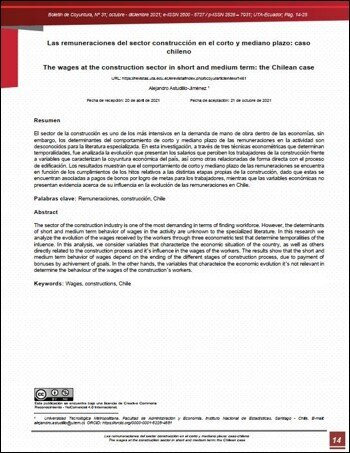The wages at the construction sector in short and medium term: the Chilean case
Main Article Content
Abstract
The sector of the construction industry is one of the most demanding in terms of finding workforce. However, the determinants of short and medium term behavior of wages in the activity are unknown to the specialized literature. In this research we analyze the evolution of the wages received by the workers through three econometric test that determine temporalities of the inluence. In this analysis, we consider variables that characterize the economic situation of the country, as well as others directly related to the construction process and it´s influence in the wages of the workers. The results show that the short and medium term behavior of wages depend on the ending of the different stages of construction process, due to payment of bonuses by achivement of goals. In the other hands, the variables that characteice the economic evolution it´s not relevant in determine the behaviour of the wages of the construction´s workers.
URL: https://revistas.uta.edu.ec/erevista/index.php/bcoyu/article/view/1461
Downloads
Article Details

This work is licensed under a Creative Commons Attribution-NonCommercial 4.0 International License.
![]()
The publications of the Boletín de Coyuntura are licensed under a Creative Commons Attribution-NonCommercial 4.0 International License (CC BY-NC 4.0). The Universidad Técnica de Ambato retains the copyright of the published works, and favors and allows the reuse of these, as long as: the authorship and original source of publication is cited, and they are not used for commercial or onerous purposes. The intellectual property of the published articles belongs to the authors.
References
Banco Central de Chile. (2020). Base de datos estadísticos. Recuperado desde https://si3.bcentral.cl/siete
Belman, D. & Voos, P. (2006). Union wages and union decline: evidence from the construction industry. Industrial and Labor Relation, 60(1), 67-87. https://doi.org/10.1177/001979390606000104
Bratsberg, B. & Raaum, O. (2012). Immigration and Wages: Evidence from Construction. The Economic Journal, 122(565), 117-1205. https://doi.org/10.1111/j.1468-0297.2012.02540.x
Cámara Chilena de la Construcción. (2020). Centro de información. Recuperado desde https://cchc.cl/centro-de-informacion/indicadores
Camino-Mogro, S. & Bermudez-Barrezueta, N. (2021).Productivity determinants in the construction sector in emerging country: New evidence from Ecuadorian firms. Review of Development Economics,, 1-23. https://doi.org/10.1111/rode.12771
Clark, M. (2005). The effects of prevailing wage laws: a comparison of individual workers´ wages earned on and off prevailing wage construction projects. Journal of Labor Research, 26(4), 725-737. https://doi.org/10.1007/s12122-005-1008-2
Correa, C., Yepes, V. & Pellicer, E. (2007). Factores determinantes y propuestas para la gestión de la innovación en las empresas constructoras. Revista Ingeniería de la Construcción, 22(1), 5-14. http://dx.doi.org/10.4067/S0718-50732007000100001
De Jorge, J., López, O. & Díaz, J. (2014). Productividad, eficiencia y sus factores explicativos en el sector de la construcción en Colombia 2005-2010. Cuadernos de Economía, 33(63), 569-588. https://doi.org/10.15446/cuad.econ.v33n63.45347
Dohmen, T. (2004). Performance, seniority, and wages: formal salary systems and individual earnings profiles. Labour Economics, 11(6), 741-763. https://doi.org/10.1016/j.labeco.2004.01.003
Drobny, A. & Wells, J. (1983). Wages, minimum wages, and income distribution in Brazil: Results from the construction industry. Journal of Development Economics, 13(3), 305-330. https://doi.org/10.1016/0304-3878(83)90002-0
Edo, A. & Rapoport, H. (2019). Minimum wages and the labor market effect of immigration. Labour Economics, 61, 101753. https://doi.org/10.1016/j.labeco.2019.101753
Flabbi, L. & Ichino, A. (2001). Productivity, seniority and wages: new evidence from personnel data. Labour Economics, 3(4), 359-387. https://doi.org/10.1016/S0927-5371(01)00024-0
García, M., Espasa, A. y Martínez, M. (1998). La aceleración del sector de la construcción en la actual coyuntura. Predicción y Diagnóstico, 33.
Goodrum, P. & Gangwar, M. (2010). The relationship between changes in equipment technology and wages in the US construction industry. Construction Management and Economics, 22(3), 291-301. Doi:10.1080/0144619032000116543
Instituto Nacional de Estadísticas. (2017). Separata técnica actualización de los indicadores coyunturales y empalme de las series IR-ICMO. Santiago de Chile.
Instituto Nacional de Estadísticas. (2020). Base de datos estadísticos de remuneraciones y costos laborales. Recuperado desde https://ine.cl/estadisticas/sociales/mercado-laboral/remuneraciones-y-costos-laborales
Kazaz, A. & Ulubeyli, S. (2007). Drivers of productivity among construction workers: A study in a developing country. Bulding and Envionment, 42(5), 2132-2140. https://doi.org/10.1016/j.buildenv.2006.04.020
König, M. & Möller, J. (2009). Impacts of minimim wages: a microdata analysis for the German construction sector. International Journal of Manpower, 30(7), 716-741. DOI: 10.1108/01437720910997362
Mizala, A. (1998). La regulación del Mercado laboral en Chile: 1975-1995. Perspectivas, 1(2) ,185-213.
Musarat, M., Alaloul, W. & Liew, M.S. (2020). Impact of inflation rate on construction projects budjet: a review. Ain Shams Engineering Jorunal, article in press. https://doi.org/10.1016/j.asej.2020.04.009
Musarat, M., Alaloul, W. y Liew, M.S., Maqsoom, A. & Qureshi, A. (2020). Investigating the impact of inflation on bulding materials prices in construction industry. Journal of Bulding Engineering, article in press.
Peralta, A. & Serpell, A. (1991). Características de la industria de la construcción. Revista Ingeniería de la Construcción, 11, 5-22.
Perloff, J. & Sickles, R. (1987). Union Wages, Hours, and Earnings Diferential in the Construction Industry. Journal of Labor Economics, 5(2), 174-210. DOI: 10.1086/298143
Robles, J. & Velázquez, L. (2001). La estructura del mercado laboral en la industria de materiales para la construcción. Análisis Económico, 16(33), 189-214.
Robles, J. & Velázquez, L. (2013). Estructura y desempeño del sector de la construcción en México. El Cotidiano, 182, 105-116.
Stefoni, C., Leiva, S. & Bonhomme, M. (2017). Migración internacional y precariedad laboral. El caso de la industria de la construcción en Chile. REMHU, 25(49), 95-112.
Williams, N. (2009). Seniority, experience, and wages in the UK. Labour Economics, 16(3), 272-283.
Zapata, G. & Hernández, A. (2010). Sistema de Incentivos y Tipos Básicos de Trabajo en la Organización Bajo la Perspectiva de la Teoría de Agencia. Pensamiento y Gestión, 29, 56-86.


